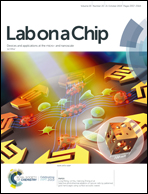Osmotic-engine-driven liposomes in microfluidic channels†
Abstract
Self-propelled underwater microrobots that locomote without external sources of energy have potential application as drug carriers and probes in narrow spaces. In this study, we focused on an osmotic engine model, which is a migration mechanism, and applied it as a negative chemotaxis mechanism to induce liposome displacement. First, we confirmed the osmotic flow across the lipid bilayer and calculated the osmotic flow velocity to be 8.5 fL min−1 μm−2 when a salt concentration difference was applied to the lipid bilayer. Next, we designed and fabricated a microchannel that can trap a giant liposome and apply a salt concentration difference to the front and rear of the liposome. Then, we demonstrated the movement of the liposome by flowing it to the microchannel. The liposome successfully moved in the direction of the lower ion concentration at a speed of 0.6 μm min−1 owing to the osmotic pressure difference. Finally, we visualized the inner flow in the liposome by encapsulating microbeads in the liposome and observed the movement of the microbeads to verify that an osmotic flow was generated on the liposome. As a result, we observed the circulation of the microbeads in the liposome when the concentration difference was applied to the front and rear of the liposome, suggesting that the movement of the liposome was driven by the osmotic flow generated by the osmotic pressure difference. These results indicate that the osmotic-pressure-based migration mechanism has the potential to be utilized as the actuator of molecular robots.



 Please wait while we load your content...
Please wait while we load your content...